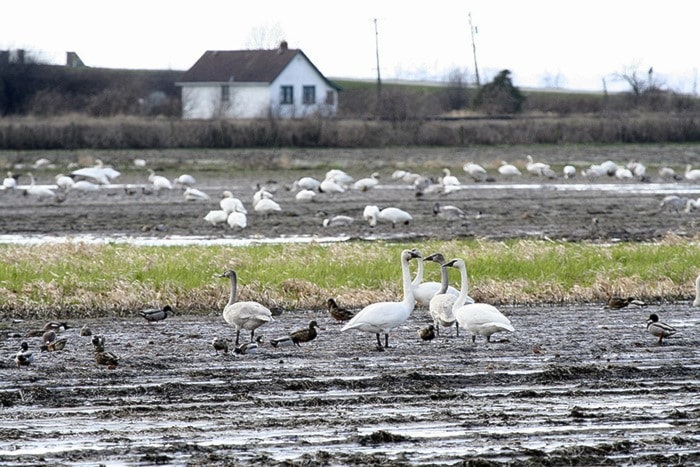An old carol, the 12 Days of Christmas, sings of “seven swans a-swimming, six geese a-laying.”
The Fraser delta is the wintering area for many swans and geese, attracted by the estuarine marshes and water-logged farm fields. Most of these waterfowl are Pacific flyway migrants, and retaining habitat for them should be an environmental priority.
Three swan species can be found locally.
The magnificent trumpeter Swans are the largest of all waterfowl. Close to extinction at one time, they have now made a successful come back and several thousand spend the winter in southern British Columbia.
Tundra swans, sometimes called whistling swans, are much less common here. A few are spotted among the trumpeter flocks each year.
The third member of the swan family, the mute swan, is an orange-billed introduction from Europe. It is resident in Ladner and a few other areas.
Swans and Snow Geese may be confused: both are big, white birds.
Swans fly with long, outstretched necks, whereas snow geese have black wing tips and form V-shaped skeins.
Both feed on sedge roots, stubble and abandoned potato crops, and are often seen crowded onto agricultural fields.
Snow geese nest on Wrangel Island, Russia. Their population varies with the weather and predators, such as Arctic foxes.
In the last few years, Mother Nature has been kind and survival of young ones has been good. Consequently, huge flocks are present in the delta this winter.
Some migrate on to California, although in smaller numbers than formerly, while others form a Skagit-Fraser delta flock that move between these two river mouths over the course of the winter.
Some Canadian geese migrate through the delta, although the most commonly seen birds are a hybrid race, introduced in the 1900s.
They are non-migratory and can be a nuisance bird.
Old timers knew many wild races, such as the small cackling goose and the dark dusky goose.
The rather similar, Greater White-fronted Goose, another northern migrant, is an uncommon visitor.
Along with Tundra Swans, it was market hunted in the early days of European settlement.
Populations may now be recovering; this fall a flock of more than 50 birds stopped at Boundary Bay.
Brant differ from other geese by feeding offshore, not on land. Most winter in Baja Calif., but some stay in Boundary Bay, grazing on eelgrass.
In spring they head north, to nest in the everlasting daylight of the Arctic islands.
Anne Murray, the author of two nature books available in local book stores, writes monthly in the Peace Arch News – www.natureguidesbc.com
